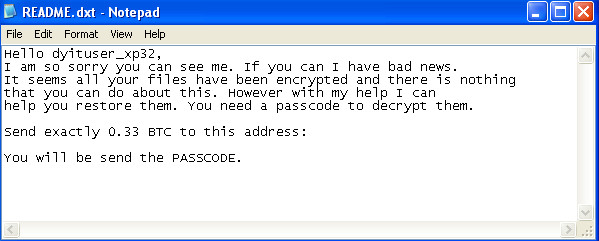RANSOM_PAYDOS.A
BAT/Filecoder.BV (ESET-NOD32); Ransom.Joke(Malwarebytes);
Windows


Threat Type: Trojan
Destructiveness: No
Encrypted: No
In the wild: Yes
OVERVIEW
This Trojan arrives on a system as a file dropped by other malware or as a file downloaded unknowingly by users when visiting malicious sites.
TECHNICAL DETAILS
Arrival Details
This Trojan arrives on a system as a file dropped by other malware or as a file downloaded unknowingly by users when visiting malicious sites.
Installation
This Trojan drops the following files:
- %AppDataLocal%\winlock.dll - contains password to unlock files
- %User Profile%\Downloads\README.txt - ransom note
- %User Profile%\Desktop\README.txt - ransom note
- %User Profile%\Documents\README.txt - ransom note
- %User Profile%\Music\README.txt - ransom note
- %User Profile%\Videos\README.txt - ransom note
- %User Profile%\Pictures\README.txt - - ransom note
(Note: %AppDataLocal% is the Application Data folder found in Local Settings, where it is usually C:\Documents and Settings\{user name}\Local Settings\Application Data on Windows 2000, Windows Server 2003, and Windows XP (32- and 64-bit); C:\Users\{user name}\AppData\Local on Windows Vista (32- and 64-bit), Windows 7 (32- and 64-bit), Windows 8 (32- and 64-bit), Windows 8.1 (32- and 64-bit), Windows Server 2008, and Windows Server 2012.. %User Profile% is the current user's profile folder, which is usually C:\Documents and Settings\{user name} on Windows 2000, XP, and Server 2003, or C:\Users\{user name} on Windows Vista and 7.)
It drops and executes the following files:
- %User Temp%\{random}.tmp\{random}.bat
(Note: %User Temp% is the user's temporary folder, where it usually is C:\Documents and Settings\{user name}\Local Settings\Temp on Windows 2000, Windows Server 2003, and Windows XP (32- and 64-bit); C:\Users\{user name}\AppData\Local\Temp on Windows Vista (32- and 64-bit), Windows 7 (32- and 64-bit), Windows 8 (32- and 64-bit), Windows 8.1 (32- and 64-bit), Windows Server 2008, and Windows Server 2012.)
It creates the following folders:
- %User Temp%\{random}.tmp
(Note: %User Temp% is the user's temporary folder, where it usually is C:\Documents and Settings\{user name}\Local Settings\Temp on Windows 2000, Windows Server 2003, and Windows XP (32- and 64-bit); C:\Users\{user name}\AppData\Local\Temp on Windows Vista (32- and 64-bit), Windows 7 (32- and 64-bit), Windows 8 (32- and 64-bit), Windows 8.1 (32- and 64-bit), Windows Server 2008, and Windows Server 2012.)
NOTES:
This ransomware will prompt you to enter password

If incorrect password was entered:

This ransomware does not encrypt files on your computer.
It renames only the following files with specific file extensions:
The ransom note, README.TXT

SOLUTION
Step 1
Before doing any scans, Windows XP, Windows Vista, and Windows 7 users must disable System Restore to allow full scanning of their computers.
Step 2
Note that not all files, folders, and registry keys and entries are installed on your computer during this malware's/spyware's/grayware's execution. This may be due to incomplete installation or other operating system conditions. If you do not find the same files/folders/registry information, please proceed to the next step.
Step 3
Search and delete these folders
- %User Temp%\{random}.tmp
Step 4
Search and delete this file
- %AppDataLocal%\winlock.dll
- %User Profile%\Downloads\README.txt
- %User Profile%\Desktop\README.txt
- %User Profile%\Documents\README.txt
- %User Profile%\Music\README.txt
- %User Profile%\Videos\README.txt
- %User Profile%\Pictures\README.txt
Step 5
Scan your computer with your Trend Micro product to delete files detected as RANSOM_PAYDOS.A. If the detected files have already been cleaned, deleted, or quarantined by your Trend Micro product, no further step is required. You may opt to simply delete the quarantined files. Please check this Knowledge Base page for more information.
Did this description help? Tell us how we did.
